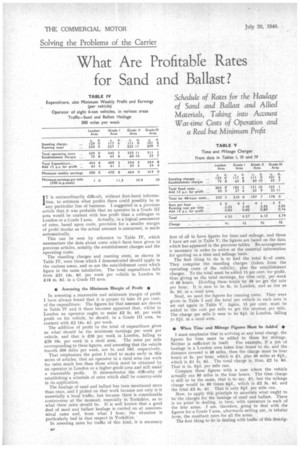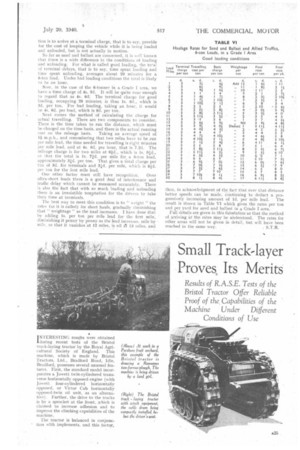Solving the Problems of the Carrier
Page 34

Page 35

If you've noticed an error in this article please click here to report it so we can fix it.
What Are Profitable Rates
for Sand and Ballast?
Schedule of Rates for the Haulage of Sand and Ballast and Allied Materials, Taking into Account War-time Costs of Operation and
a Real but Minimum Profit
IT is extraordinarily difficult, without first-hand information, to estimate what profits there could possibly be in any particular line of businees. I suggested in a previous article that it was probable that an operator in a Grade III area would be content with less profit than a colleague in London or a Grade I area. Actually, in a logical assessment of rates, based upon costs, provision for a smaller margin of profit insofar as the actual amount is concerned, is made automatically.
This can be seen by reference to Table IV, which summarizes the data about costs which have been given in previous articles, notably the establishment charges and the operating costs.
The standing charges and running costs, as shown in Table IV, were those which I demonstrated should apply in the various areas, and so are the establishment costs which figure in the same tabulation. The total expenditure falls from £21 14s. 8d. per week per vehicle in London to 418 4s. 8d. in a Grade III area.
• Assessing the Minimum Margin of Profit • In assessing a reasonable and minimum margin of profit I have always found that it is proper to take 15 per cent. of the expenditure. The figures for that amount are shown in Table IV and it there becomes apparent that, whilst in London an operator ought to make £3 5s. 4d. per week profit on his vehicle, he should, in a Grade III area, be content with £2 14s. 4d. per week.
The addition of profit to the total of expenditure gives us what should be the minimum earnings per week per vehicle, and that is £25 per week in London, falling to £20 19s. per week in a rural area. The rates per mile corresponding to these figures, and assuming that the vehicle travels 500 miles per week, are Is. and 10d. respectively.
That emphasizes the point I tried to make early in this series of articles, that an operator in a rural area can work for rates much less than those which must be obtained by an operator in London or a higher-grade area and still make a reasonable profit. It demonstrates the difficulty of establishing a schedule of rates which shall be country-wide in its application.
The haulage of sand and ballast has been mentioned more than once, and I picked on that work because not only is it essentially a local traffic, but because there is considerable controversy at the moment, especially in Yorkshire, as to what these rates should be. It is well known that a good deal of sand and ballast haulage is carried on at uneconomical rates and, from what I hear, the situation is particularly bad in that respect in Yorkshire. In assessing rates for traffic of this kind, it is necessary first of all to have figures for time and mileage, and those I have set out in Table V; the figures are based on the data which has appeared in the previous tables. Re-arrangement is necessary in order to arrive at the essential information for quoting on a time and mileage basis.
The first thing to do is to find the total fieed costs. They comprise the standing charges (taken from the operating costs of the vehicle), plus the establishment charges. To the total must be added 15 per cent, for profit, thus giving us the total earnings, for time only, per week of 48 hours. Dividing these totals by 48 we get the rate per hour. It is seen to be 5s. in London, and as low as 3s. 9d. in a rural area.
Next, we need the figures for 'running costs. They were given in Table I and the total per vehicle in each area is set out again in Table V. Again, 15 per cent, must be added to the cost per mile to get the revenue per mile. The charge per mile is seen to be Eild. in London, falling to 5d. in a rural area.
• When Time and Mileage Figures Must be Added •
I must emphasize that in arriving at any total charge, the figures for time must be added to those for mileage.
Neither is sufficient in itself. For example, if a job of haulage in a London area takes four hours to do, and the distance covered is 40 miles, then the charge must be four hours at 5s. per hour, which is £1, plus 40 miles at W., which is £1 Is. 8d. The total charge is, thus, £2 Is. 8d. That is Is. Ofd. per mile run.
Compare these figures with a case where the vehicle actually ran 80 miles in the four hours. The time charge is still to be the same, that is to say, £1, but the mileage charge would be 80 times 614., which is £2 3s. 4d. and the total E3 3s. 4d. That is only 9fd. per mile run.
Now, to apply this principle to ascertain what ought to be the charges for the haulage of sand and ballast. There is no point in dealing, in turn, with operators in each of the four areas. I am, therefore, going to deal with the figures for a Grade I area, afterwards setting out, in tabular form, the resultant rates for all the areas.
The first thing to do in dealing with traffic of this descrip tion is to arrive at a terminal charge, that is to say, provide for the cost of keeping the vehicle while it is being loaded and unloaded, but is not actually in motion.
So far as sand and ballast are concerned, it is well known that there is a wide difference in the conditions of loading and unloading. For what is called good loading, the toLai of terminal delays, that is to say, time spent loading and time spent unloading, averages about 20 minutes for a 6-ton load. Under bad loading conditions the total is likely to be an hour.
Now, in the case of the 6-tonner in a Grade I area, we have a time charge of 4s. 5d. It will be quite near enough to regard that as 4s. 6d: The terminal charge for good loading, occupying 20 minutes, is thus is. 6d., which is 3d. per ton. For bad loading, taking an hour, it would be 4s. 6d, per load, which is 9d. per ton, Next comes the methnd of calculating the charge. for actual travelling. There are two components to consider. There is the time taken to run the distance, which must be charged on the time basis, and there is the actual running
cost on the mileage basis. Taking an average speed of 15 m.p.h., and remembering that two miles have to be run per mile lead, the time needed for travelling is eight minutes per mile lead, and at 4s. 611. per hour, that is 7.2d. The mileage charge is for two miles at 60., which is Is. Oid., so that the total is Is. 72d. per mile for a 6-ton load, approximately 3id. per.ton. That gives a total charge.per ton of 3d. for terminals and 30. per mile, which is 6id. per ton for the first mile lead.
One other factor must still have recognition. Over ultra-short leads there is a good deal of interference and traffic delay which cannot be measured accurately. There is also the fact that with so much loading and unloading there is an irresistible temptation for the drivers to take their time at terminals.
The best way to meet this condition is to " weight " the rates (as it is called) for short hauls, gradually diminishing that " weightage " as the haul increases. I have done that by adding Is. per ton per mile lead for the first mile, diminishing it penny by penny as the lead increases, mile by mile, so that it vanishes at 12 miles, is nil al 13 miles, and
then, in acknowledgment of the fact that over that distance better speeds can be made, COntinning to deduct a pro gressively increasing amount of -.1d. per mile lead. The result is shown in Table VI which gives the rates per ton and per yard for sand and ballast in a Grade I area. Full details are given in thiS fabulation. so that the method of arriving at the rites may be understood. The rates for other areas will not be given in detail, but will have been
reached in the same way. S.T.R.




























































